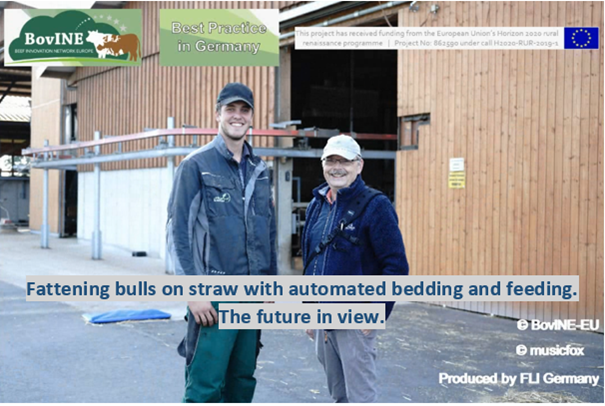The farm presented here has two stables for 600 bulls. The decision for bull fattening on straw was consumer-oriented with long-term use. Although the farmer runs the business with his two sons, they have opted for automatic bedding and feeding systems for economic reasons. Both stables have a wide ridge with light and alongside wind protection nets. The bulls (Simmental, Brown Swiss) are bought from one breeder in 4 cohorts, so 4 sales of 150 bulls each can take place between autumn and spring.
A stable has 12 pens (10m deep, 10m wide) for 25 animals each (4 m2 per animal). On the rear half of the pen there is the bedding area and the front half near to the feeding table with the neck bars forms the walking alley. The walking alley is concrete with a slight slope over the whole stable, it is cleaned regularly. Partition grids, which divide the walking area every 5m, serve to keep off the animals during cleaning.
The bedding area is littered with straw daily by an automatic device. Feed is presented and pushed several times a day, by robots (company Wasserbauer).
Please click on the picture to see the video (Video by F. Zerbe)!
The time saved by automatic systems can be used for more animal controls. Furthermore, an intensive animal control is carried out during cleaning the concrete alley when the animals are on the litter area. The feed consumption can be recorded by the feeding robot for each group. Challenging is the fact that the capacity of the machine for littering the pens is too low in the finishing phase. The farmer has to spread additional straw with a wheel loader. Nevertheless, the typical soiling on the animals (especially the cushions on the carpal joints) can be found here.
The walking areas, where manure has to be pushed off regularly, tend to become smooth over time. However, this cleaning is necessary to keep claws and skin dry and healthy. Measures must be taken to minimize the animals slipping and to provide walking on abrasive surfaces.
When keeping fattening bulls on straw well-tended bedding can be recognized by the carpal joints where you can still see the coat. Important points are suitable drainage and good ventilation to dry surfaces and skin. Robots can help to be more flexible in labor time and move time from routine works to animal control.
This Good Practice has an Impact on:
- Socio-economic resilience: The costs for the automatic bedding machine and feeding robot are not higher than for conventional methods. Since farming on straw is labor-intensive, automation should be considered
- Animal health and welfare: Bull fattening on straw can be considered a standard practice. In addition, areas for claw wear have to be offered. Straw farms require good litter management, as there is always the risk of increased animal dirtiness. Soiling restricts animal control and affects the integument
- Production efficiency and meat quality: Feeding robots allow the feed consumption to be monitored
- Environmental sustainability: Straw is a renewable resource. Manure is a good humus-forming agent. Both bind CO2
In terms of straw bedding see also Straw bedding for finisher bulls (on the BovINE Knowledge Hub).
